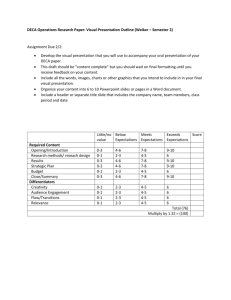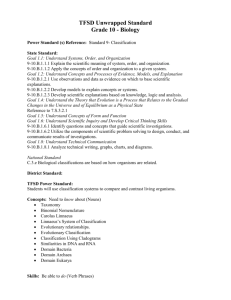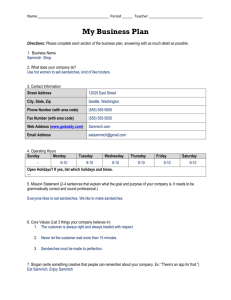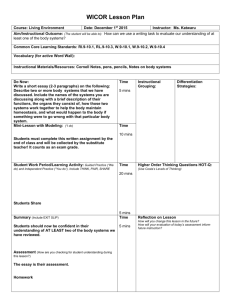File - Herold English
advertisement
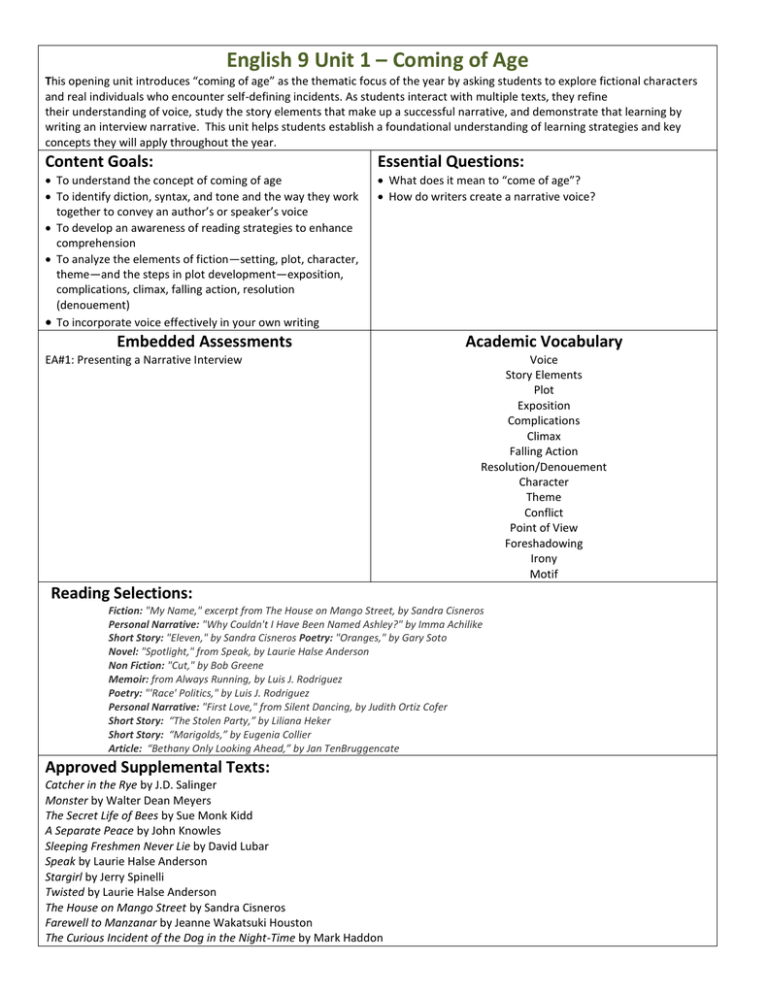
English 9 Unit 1 – Coming of Age This opening unit introduces “coming of age” as the thematic focus of the year by asking students to explore fictional characters and real individuals who encounter self-defining incidents. As students interact with multiple texts, they refine their understanding of voice, study the story elements that make up a successful narrative, and demonstrate that learning by writing an interview narrative. This unit helps students establish a foundational understanding of learning strategies and key concepts they will apply throughout the year. Content Goals: Essential Questions: To understand the concept of coming of age To identify diction, syntax, and tone and the way they work together to convey an author’s or speaker’s voice To develop an awareness of reading strategies to enhance comprehension To analyze the elements of fiction—setting, plot, character, theme—and the steps in plot development—exposition, complications, climax, falling action, resolution (denouement) To incorporate voice effectively in your own writing What does it mean to “come of age”? How do writers create a narrative voice? Embedded Assessments EA#1: Presenting a Narrative Interview Academic Vocabulary Voice Story Elements Plot Exposition Complications Climax Falling Action Resolution/Denouement Character Theme Conflict Point of View Foreshadowing Irony Motif Reading Selections: Fiction: "My Name," excerpt from The House on Mango Street, by Sandra Cisneros Personal Narrative: "Why Couldn't I Have Been Named Ashley?" by Imma Achilike Short Story: "Eleven," by Sandra Cisneros Poetry: "Oranges," by Gary Soto Novel: "Spotlight," from Speak, by Laurie Halse Anderson Non Fiction: "Cut," by Bob Greene Memoir: from Always Running, by Luis J. Rodriguez Poetry: "'Race' Politics," by Luis J. Rodriguez Personal Narrative: "First Love," from Silent Dancing, by Judith Ortiz Cofer Short Story: “The Stolen Party,” by Liliana Heker Short Story: “Marigolds,” by Eugenia Collier Article: “Bethany Only Looking Ahead,” by Jan TenBruggencate Approved Supplemental Texts: Catcher in the Rye by J.D. Salinger Monster by Walter Dean Meyers The Secret Life of Bees by Sue Monk Kidd A Separate Peace by John Knowles Sleeping Freshmen Never Lie by David Lubar Speak by Laurie Halse Anderson Stargirl by Jerry Spinelli Twisted by Laurie Halse Anderson The House on Mango Street by Sandra Cisneros Farewell to Manzanar by Jeanne Wakatsuki Houston The Curious Incident of the Dog in the Night-Time by Mark Haddon Power and Complementary Standards PS: SL 9-10.1 Initiate and participate effectively in a range of collaborative discussions with diverse partners, building on others’ ideas and expressing their own clearly and persuasively CS: RL 9-10.2 Determine a theme or central idea of a text and analyze in detail its development over the course of the text, including how it emerges and is shaped and refined by specific details; provide an objective summary of the text (3.4.3) CS: RI 9-10.2 Determine a central idea and analyze its development over the course of the text, including how it emerges and is shaped and refined by specific details; provide an objective summary of the text (3.4.3) PS: SL 9-10.1 Initiate and participate effectively in a range of collaborative discussions with diverse partners, building on others’ ideas and expressing their own clearly and persuasively PS: RL 9-10.5 Analyze how an author’s choices concerning how to structure a text, order events within it (e.g., parallel plots), and manipulate time (e.g., pacing, flashbacks) create such effects as mystery, tension, or surprise. (2.3.1, 3.4.2) PS: RI 9-10.4 Determine the meaning of words and phrases as they are used in the text, including figurative , connotative, and technical meanings; analyze the cumulative impact of specific word choices on meaning and tone (1.3.2, 2.3.3, 2.4.2, 2.4.4) PS: SL 9-10.1 Initiate and participate effectively in a range of collaborative discussions with diverse partners, building on others’ ideas and expressing their own clearly and persuasively PS: RI 9-10.4 Determine the meaning of words and phrases as they are used in the text, including figurative , connotative, and technical meanings; analyze the cumulative impact of specific word choices on meaning and tone (1.3.2, 2.3.3, 2.4.2, 2.4.4) Core Curriculum 1.1 Previewing the Unit preview the unit and introduce the key concepts of coming of age and voice and establish procedures for ongoing work with strategy Learning Logs and student-selected novels 1.2 Coming of Age: Let Me Count the Ways! preview the unit and introduce key concepts of coming of age and voice and establish procedures for ongoing work with Learning Logs and student-selected novels 1.3 What's in a Name? preview the unit and introduce the key concepts of coming of age and voice and establish procedures for ongoing work with strategy Learning Logs and student-selected novels 1.4 I'd Like to Introduce? preview the unit and introduce the key concepts of coming of age and voice and establish procedures for ongoing work with strategy Learning Logs and student-selected novels PS: SL 9-10.4 Present information, findings, and supporting evidence clearly, concisely, and logically such that listeners can follow the line of reasoning and the organization, development, substance, and style are appropriate to purpose, audience, and task CS: SL 9-10.6 Adapt speech to a variety of contexts and tasks, demonstrating command of formal English when indicated or appropriate PS: RL 9-10.5 Analyze how an author’s choices concerning how to structure a text, order events within it (e.g., parallel plots), and manipulate time (e.g., pacing, flashbacks) create such effects as mystery, tension, or surprise. (2.3.1, 3.4.2) 1.5 Introduction to Learning Logs and Word Walls preview the unit and introduce the key concepts of coming of age and voice and establish procedures for ongoing work with strategy Learning Logs and student-selected novels 1.7 Defining Moments use multiple texts, including essays, novel excerpts, and poems, to analyze the components of voice and coming of age PS: RI 9-10.4 Determine the meaning of words and phrases as they are used in the text, including figurative , connotative, and technical meanings; analyze the cumulative impact of specific word choices on meaning and tone (1.3.2, 2.3.3, 2.4.2, 2.4.4) CS: RL 9-10.2 Determine a theme or central idea of a text and analyze in detail its development over the course of the text, including how it emerges and is shaped and refined by specific details; provide an objective summary of the text (3.4.3) 1.8 Getting Cut: Coming of Age the Hard Way use multiple texts, including essays, novel excerpts, and poems, to analyze the components of voice and coming of age CS: RI 9-10.2 Determine a central idea and analyze its development over the course of the text, including how it emerges and is shaped and refined by specific details; provide an objective summary of the text (3.4.3) PS: RI 9-10.4 Determine the meaning of words and phrases as they are used in the text, including figurative , connotative, and technical meanings; analyze the cumulative impact of specific word choices on meaning and tone (1.3.2, 2.3.3, 2.4.2, 2.4.4) 1.9 Two Versions of One Memory use multiple texts, including essays, novel excerpts, and poems, to analyze the components of voice and coming of age PS: W 9-10.3 Write narratives to develop real or imagined experiences or events using effective technique, well-chosen details, and well-structured event sequences (2.1.1, 2.2.1, 2.3.1, 3.1.1, 3.1.2) PS: RI 9-10.1 Cite strong and thorough textual evidence to support analysis of what the text says explicitly as well as inferences drawn from the text (2.4.1) 1.10 Conversations with Characters use multiple texts, including essays, novel excerpts, and poems, to analyze the components of voice and coming of age 2.10 “The Stolen Party”—Close Reading 2.12 Point of View in “The Stolen Party” PS: RI 9-10.4 Determine the meaning of words and phrases as they are used in the text, including figurative , connotative, and technical meanings; analyze the cumulative impact of specific word choices on meaning and tone (1.3.2, 2.3.3, 2.4.2, 2.4.4) PS: W 9-10.9 Draw evidence from literary or informational texts to support analysis, reflection, and research CS: W 9-10.1 Write arguments to support claims in an analysis of substantive topics or texts, using valid reasoning and relevant and sufficient evidence (2.2.1, 2.3.1,3.1.1, 3.1.2) PS: RL 9-10.3 Analyze how complex characters (e.g., those with multiple or conflicting motivations) develop over the course of a text, interact with other characters, and advance the plot or develop the theme (3.4.3) PS: RL 9-10.3 Analyze how complex characters (e.g., those with multiple or conflicting motivations) develop over the course of a text, interact with other characters, and advance the plot or develop the theme (3.4.3) PS: RL 9-10.5 Analyze how an author’s choices concerning how to structure a text, order events within it (e.g., parallel plots), and manipulate time (e.g., pacing, flashbacks) create such effects as mystery, tension, or surprise (2.3.1, 3.4.2) PS: RI 9-10.4 Determine the meaning of words and phrases as they are used in the text, including figurative , connotative, and technical meanings; analyze the cumulative impact of specific word choices on meaning and tone (1.3.2, 2.3.3, 2.4.2, 2.4.4) CS: RL 9-10.2 Determine a theme or central idea of a text and analyze in detail its development over the course of the text, including how it emerges and is shaped and refined by specific details; provide an objective summary of the text (3.4.3) 2.13 “The Stolen Party” Story Diagram 2.14 SIFTing through “Marigolds” 1.12 Viewing an Interview focus on interviewing skills to capture and convey the voice of another. Students watch a video interview, read a published CS: RI 9-10.2 Determine a central idea and analyze its development over the course of the text, including how it emerges and is shaped and refined by specific details; provide an objective summary of the text (3.4.3) PS: RI 9-10.4 Determine the meaning of words and phrases as they are used in the text, including figurative , connotative, and technical meanings; analyze the cumulative impact of specific word choices on meaning and tone (1.3.2, 2.3.3, 2.4.2, 2.4.4) CS: RL 9-10.2 Determine a theme or central idea of a text and analyze in detail its development over the course of the text, including how it emerges and is shaped and refined by specific details; provide an objective summary of the text (3.4.3) CS: RI 9-10.2 Determine a central idea and analyze its development over the course of the text, including how it emerges and is shaped and refined by specific details; provide an objective summary of the text (3.4.3) PS: RI 9-10.4 Determine the meaning of words and phrases as they are used in the text, including figurative , connotative, and technical meanings; analyze the cumulative impact of specific word choices on meaning and tone (1.3.2, 2.3.3, 2.4.2, 2.4.4) PS: W 9-10.3 Write narratives to develop real or imagined experiences or events using effective technique, well-chosen details, and well-structured event sequences (2.1.1,2.2.1,2.3.1,3.1.1,3.1.2) PS: W 9-10.4 Produce clear and coherent writing in which the development, organization, and style are appropriate to task, purpose, and audience (2.1.1,2.2.1,2.3.1,3.1.2,3.2.1) PS: SL 9-10.4 Present information, findings, and supporting evidence clearly, concisely, and logically such that listeners can follow the line of reasoning and the organization, development, substance, and style are appropriate to purpose, audience, and task CS: W 9-10.5 Develop and strengthen writing as needed by planning, revising, editing, rewriting, or trying a new approach, focusing on addressing what is most significant for a specific purpose and audience (1.1, 1.2, 1.6, 3.1.1) CS: W 9-10.6 Use technology, including the Internet, to produce, publish, and update individual or shared writing products, taking advantage of technology’s capacity to link to other information and to display information flexibly and dynamically. CS: SL 9-10.6 Adapt speech to a variety of contexts and tasks, demonstrating command of formal English when indicated or appropriate interview, conduct a group interview, and plan for the independent interview assignment of Embedded Assessment 1 1.13 Reading an Interview Narrative focus on interviewing skills to capture and convey the voice of another. Students watch a video interview, read a published interview, conduct a group interview, and plan for the independent interview assignment of Embedded Assessment 1 1.14 Interviewing Together focus on interviewing skills to capture and convey the voice of another. Students watch a video interview, read a published interview, conduct a group interview, and plan for the independent interview assignment of Embedded Assessment 1 1.15 Planning an Interview focus on interviewing skills to capture and convey the voice of another. Students watch a video interview, read a published interview, conduct a group interview, and plan for the independent interview assignment of Embedded Assessment 1 Embedded Assessment 1: Presenting an Interview Narrative

